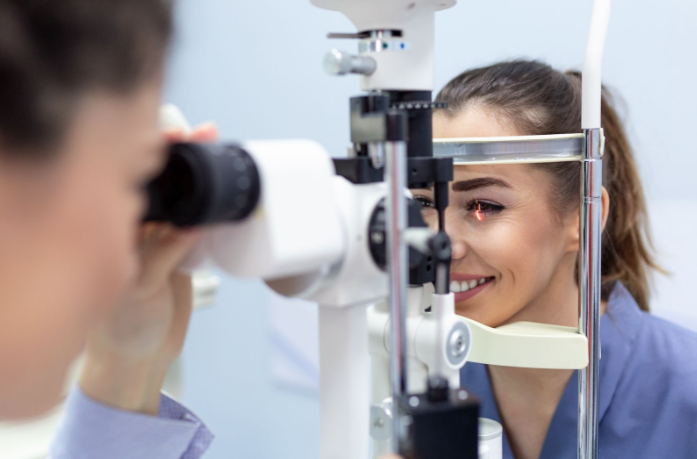
Is 2024 the year you launch your new practice? Or are you planning to add an exam lane to your existing practice? If so, you have likely spent some time thinking about the instruments and equipment you will need to ensure the exam process runs smoothly, results are accurate, and you and your patients are comfortable.
Nowadays, a digital practice is the best solution for overall efficiency.
Digital technology has revolutionized the modern eye exam, enabling eye care professionals to eliminate costly inefficiencies while making the exam process easier and more enjoyable overall. In fact, doctors who make the switch to digital are often able to see more patients per exam room, per day.
Below is a list of key foundational equipment you will need when outfitting your new practice.
Exam Chair, Stand & Stool
Starting with the basics, these three pieces of furniture will be the foundation of your exam lane. Since most exam rooms are small, choosing the right pieces is critical for both accessibility and space—not to mention your and your patients' comfort. These items may be purchased separately or as a cost-efficient bundle.
Digital Refraction System
Digital refraction systems have become the equipment standard in modern-day ophthalmic practices. Typically, like the Veatch Digital Refraction Suite, a complete digital refraction system will include a digital refractor, an auto refractor/keratometer, a visual acuity system, and an auto lensmeter. While they use the same methods as traditional manual equipment, digital refractors offer far more functionality, and doctors report the following benefits:
- Increased efficiency
- High return on investment
- Easy connectivity of equipment
- Improved accuracy, fewer mistakes
- Reduced pain and discomfort (due to elimination of repetitive motion)
- Greater patient satisfaction (to more one-on-one time with doctors)
- Increased optical sales
- Easy integration with EMR
Auto Refractor/Keratometer
The auto refractor/keratometer allows for fast, accurate identification of the correct eyeglasses or contact lens prescription for your patients. Doctors can easily measure refraction and keratometry in a sequence, and results can be checked simultaneously for increased efficiency.
Visual Acuity System
Visual acuity testing is a critical component for diagnosing myopia in your patients. And thanks to improved LED screens and cutting-edge computer software, modern doctors can test patients in any size room (instead of having them stand 20 feet from the eye chart) and are able to access dozens of different charts at the push of a button.
Lensometer (Lensmeter)
Technology has grown rapidly in just about every industry—particularly the medical field—and auto lensmeters are the technological step up from manual lensometry. While manual lensometers can read the data of prescription eyeglasses, auto lensmeters eliminate the subjective nature, reducing operator error and offering repeatable measurements. They are also fast and easy to use—immediately printing out the measurement data once the analysis is complete.
Slit lamp
A slit lamp biomicroscope (or simply slit lamp) allows you to more effectively gauge patient eye health and identify any diseases, injuries, or underlying health issues. It is an essential component of the exam process and necessary for protecting and preserving healthy vision. Depending on your optic needs, lighting style preference, and magnification specifications, there are many different kinds of slit lamps available.
Some options, including the ReSeeVit 3Z Digital LED Slit Lamp, are designed for use with digital video imaging. Slit lamp imaging capabilities allow doctors to more effectively monitor disease progression while improving documentation and patient education.
Tonometer
Especially important when building a glaucoma practice, a tonometer measures pressure in the eyes and is an important tool for measuring the effectiveness of glaucoma treatment. ECPs can choose a standard tonometer, a non-contact tonometer (NCT), or handheld tonometer like the Reichert Tonopen AVIA or the AccuPen Handheld Tonometer.
Additional Digital Options
Depending on your budget and the scope of your practice, there are several other digital equipment options available to ECPs today.
For example, if you want to focus on myopia management, one of the best things you can do is invest in a corneal topography solution. One great option is the Topcon MYAH Biometer & Corneal Topographer, which combines corneal topography, pupillometry, anterior cornea wavefront analysis, and contact lens fitting tools, making it a comprehensive device for monitoring axial length.
A high-quality retinal camera is also an excellent investment. In addition to facilitating the early detection of conditions that can impact healthy vision (such as diabetic retinopathy and AMD), they generate images quickly that can then be uploaded easily to your EMR. We've listed a few of our top picks here.
Finally, VR perimetry solutions like the Olleyes VisuALL ETS Comprehensive Testing Suite offer a more convenient, comfortable, and efficient alternative to traditional bowl perimeters to help you streamline exam time and ensure a comfortable, stress-free testing experience for your patients.
Did you know our design consultants can help you plan and put together your ideal practice?
Veatch uses state-of-the-art technology to help you map out the most efficient arrangement and choose the right equipment, taking into account your specific needs, projected patient volume, potential for growth, and other key factors. Whether you need layout advice for a new office or you want to modernize your current exam lane(s) with the latest digital equipment, contact us today to get started.